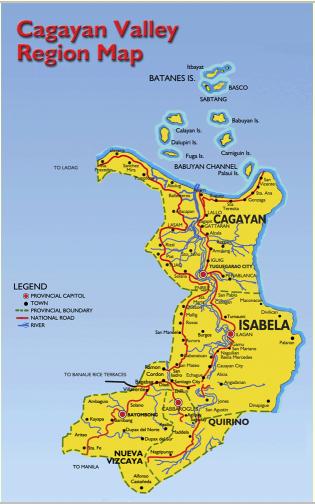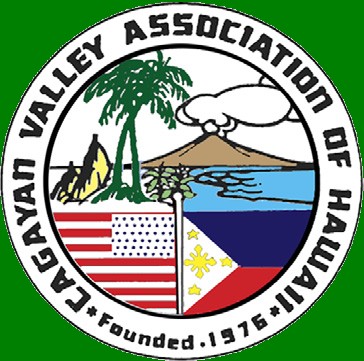|
About Us
Events
Gallery
Links
Contact Us
Guestbook

|
|
Regional Center............................Tuguegarao
City, Philippines
Divisions:
- Provinces............................5
- Cities...................................4
- Municipalities....................89
- Barangays..........................2,311
- Congressional Districts....10
- Languages..........................Ilokano, Ibanag,
Ivatan, Itawis, Gaddang, and others.
Cagayan Valley (Lambak ng Cagayan in filipino) is a
region of the Philippines, also designated as Region 2. It is composed of 5
provinces namely, Batanes, Cagayan, Isabela, Nueva Vizcaya, and Quirino. Its
regional center is Tuguegarao City. Most of the region lies in a large
valley in northeastern Luzon, between the Cordilleras and the Sierra Madre
mountain ranges. Cagayan River, the country's longest river runs through its
center and flows out to Luzon Strait in the north, in the town of Appari,
Cagayan. The Babuyan and Batanes island groups that lie in the Luzon Strait
also belong to the region.
Economy - The Cagayan Valley region is defined by
the Cagayan River, the largest in the Philippines. The province of Cagayan
occupies the lower course of the river, and the northeast corner of the
island of Luzon (with a few offshore islets), Cagayan's area is 9,003 square
kilometers, its population 952,000 (year 2000 census) in 29 towns, of which
Tuguegarao is the capital.
Archaeology indicates that the Cagayan Valley has been
inhabited for half a million years, though n human remains of any such
antiquity have yet appeared. The earliest inhabitants are the Agta or Atta,
food-gatherers who roam the forest without fixed abode. A large tract of
land has lately been returned to them. The bulk of the population are of
Malay origin. For centuries before the coming of the Spanish, the
inhabitants traded with the Indians, Malays, Chinese, and Japanese. In the
19th century the prosperity found in tobacco cultivation caused many
Ilocanos to settle here. Tobacco is still a major factor in the economy of
Cagayan, though a special economic zone and free port has been created to
strengthen and diversify the provincial economy. Cagayan has much to offer
visitors: beaches, swimming, snorkeling, skin-diving, fishing in the river
and the sea, hiking in primeval forest, mountain-climbing, archaeological
sites, the remarkable collection of the provincial museum, the Callao Caves,
and many fine churches. Even here there are fortifications built to protect
the inhabitants from raids by the Moros.
The Philippine Republic's Region 2, Cagayan Valley,
contains 2 landlocked provinces; Quirino and Nueva Vizcaya. Both are
relatively small in size (3,057 square kilometer for Quirino, 4,081 square
kilometer for Nueva Vizcaya) and population (147,000 and 365,000
respectively by the year 2000 census). Both are ruggedly mountainous and
heavily forested. Nueva Vizcaya is the remnant of the southern province
created when Cagayan Province was divided in two in 1839. Both are
ethnically and linguistically diverse, with a substrate of Agtas, Negritos
who are food-gatherers with no fixed abode; overlaid by Ilonggos and others
in a number of tribes, some of whom were fierce head-hunters until recently
(we are firmly assured that they have given up the practice), with the
latest but largest element of the population being Ilocanos. Nueva Vizcaya
comprises 15 towns; Bayombong is the capital. Agriculture in both has until
recently consisted of slash-and-burn cultivation of corn and maize, though
more stable cultivation of vegetables and fruits is becoming established.
Both also produce logs, and are trying to manage their forest resources so
that production can be sustained indefinitely. They have deposits of gold,
silver, copper, iron. Nueva Vizcaya has sand and clay. At Balete Pass in
Nueva Vizcaya the retreating Japanese under General Yamashita dug in and
held on for three months against the Americans and Filipino Forces who
eventually drove them out; the pass is now called Dalton Pass in honor of
General Dalton, USA who was killed in the fighting.
Nueva Vizcaya was probably named after Vizcaya (English
'Biscay', Basque 'Bizkala') province in northern pain. In this case there is
some vexillological relationship between them, as the flag of of New Biscay
bears the arms of Biscay impaled on its seal.
|
Province |
|
Capital |
| |
|
|
| Batanes |
|
Basco |
| Cagayan |
|
Tuguegarao City |
| Isabela |
|
Ilagan |
| Nueva Vizcaya |
|
Bayombong |
| Quirino |
|
Cabarroguis |
|

![]()
